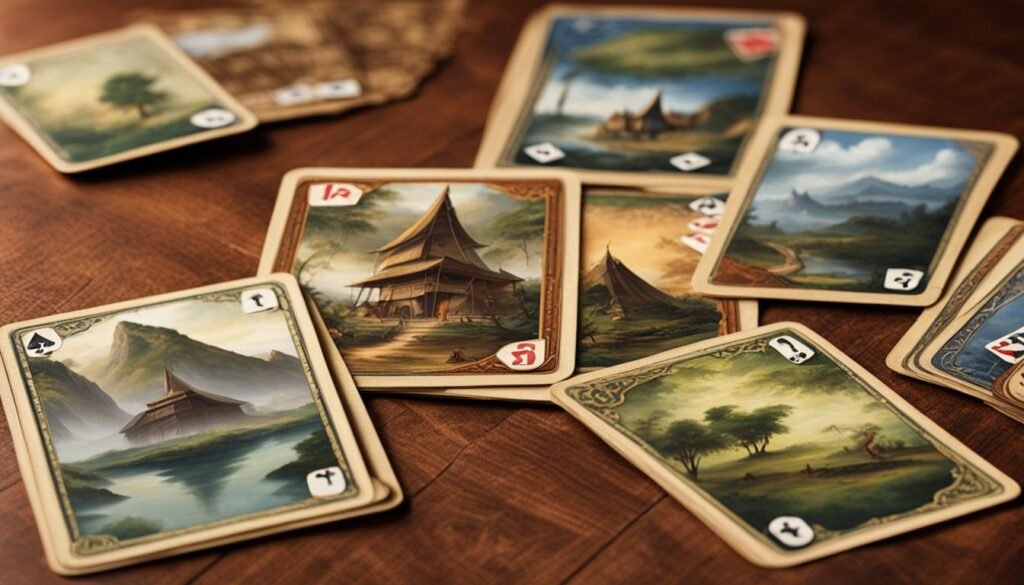Welcome to a captivating journey through the history of card games! From ancient civilizations to modern times, card games have enchanted people of all ages and backgrounds with their endless possibilities and strategic challenges. In this article, we will explore the origins, evolution, and cultural significance of card games, shedding light on their enduring appeal.
Card games have a rich and diverse history, dating back centuries. They have been enjoyed by kings and peasants alike, transcending social boundaries and offering entertainment for all. Whether it’s a friendly game of poker or a high-stakes blackjack tournament, card games have always managed to bring people together.
So, why have card games stood the test of time? The answer lies in their universal appeal. Regardless of language or culture, the rules of the game remain constant, creating a shared experience that transcends borders. Card games have become an integral part of our social fabric, providing endless hours of fun and bonding.
As we delve deeper into the history of card games, we will uncover their origins in ancient civilizations such as China and Egypt. We will explore how these early card games evolved and spread across different regions, adapting to the unique cultures they encountered along the way.
Join us on this fascinating journey as we unlock the secrets of the past and discover the timeless allure of card games.
Key Takeaways:
- Card games have a long and diverse history, dating back centuries.
- They bridge social gaps and bring people together, offering universal entertainment.
- The origins of card games can be traced back to ancient civilizations.
- Card games have adapted to different cultures and continue to evolve.
- The allure of card games lies in their enduring appeal and shared experience.
Origins of Card Games
Card games have a rich and fascinating history that stretches back centuries. To truly appreciate the evolution of these beloved games, it’s essential to explore their origins and understand how they emerged in different cultures around the world.
The origins of card games can be traced back to ancient civilizations, where early forms of playing cards were used for various purposes. One theory suggests that the first playing cards originated in China during the Tang Dynasty (618-907 AD), known as “The Leaf Game” or “Yeh-Tzse.” These cards, which were likely hand-painted, featured various designs and were primarily used for entertainment purposes.
The Chinese cards gradually made their way to the Middle East and eventually spread to Europe during the 14th century. It was in Europe where the modern deck of cards, as we know it today, began to take shape.
As playing cards gained popularity, different regions started developing their own unique suits and symbols. For example, the French deck, consisting of hearts, diamonds, clubs, and spades, became the standard in many countries. Meanwhile, the German and Italian decks featured different suits such as acorns and swords, reflecting the cultural influences of these regions.
“The origins of card games can be traced back to ancient civilizations.”
Throughout history, playing cards have been used for various purposes beyond pure entertainment. They were often used for educational and instructional purposes, demonstrating moral lessons or teaching important skills such as arithmetic and language.
Today, playing cards continue to captivate people of all ages and backgrounds. The timeless appeal of card games lies in their simplicity, versatility, and the endless possibilities they offer for strategic thinking and social interaction.
Evolution of Card Games
Throughout history, card games have undergone a fascinating evolution, adapting to the changing times and cultures. From their humble beginnings to the complex games we know today, the evolution of card games showcases human ingenuity and the desire for entertainment. Let’s dive into the development and progression of these beloved games.
The Early Years
The origins of card games trace back to ancient civilizations such as China, India, and Egypt. However, it was in 14th-century Europe where playing cards as we know them today started to take shape. Initially, cards were hand-painted and expensive, limited to the elite classes. Over time, their popularity grew, leading to mass production and accessibility for a wider audience.
A Standardized Experience
As card games spread across continents, different regional variations emerged, each with their own rules and designs. However, in the 18th century, the desire for standardization arose. This led to the creation of international decks, such as the French-suited deck and the English-suited deck, which streamlined gameplay and made the games more accessible to players worldwide.
Innovations in Design and Functionality
As card games became more popular, the evolution of designs and functionality added new dimensions to gameplay. Card backs featured intricate patterns, vibrant colors, and thematic illustrations, enhancing the overall aesthetic appeal and immersing players in the game. Additionally, various card game accessories, such as shuffling machines and card holders, were introduced to simplify gameplay and enhance the player experience.
The Rise of Modern Card Games
In the 20th century, the modern card game industry experienced a significant boom. New games emerged, catering to different player preferences and introducing innovative gameplay mechanics. Classic games like Poker and Bridge gained widespread popularity, while new games like Magic: The Gathering revolutionized the industry with collectible card games.
Evolution of Card Games
| Time Period | Key Developments |
|---|---|
| Ancient Times | Early card games originate in China, India, and Egypt. |
| 14th Century | Playing cards spread to Europe and begin to take shape. |
| 18th Century | Standardization of international decks leads to global accessibility. |
| 20th Century | New games and innovative mechanics revolutionize the industry. |
The evolution of card games continues to this day, with ongoing innovation and the introduction of digital platforms. From traditional favorites to modern masterpieces, the world of card games thrives on the exciting evolution of gameplay and the timeless enjoyment it brings to players around the globe.
Cultural Significance of Card Games
Card games have played an integral role in shaping the cultural fabric of societies around the world. From social gatherings to gambling dens, these games have weaved their way into the very essence of our communities. Whether it’s a friendly game of poker among friends or a high-stakes match in a prestigious casino, card games have transcended mere entertainment to become a significant part of our cultural heritage.
The Social Setting
Card games act as a conduit for human connection. Whether it’s a family gathering, a friendly get-together, or a community event, card games create opportunities for bonds to form and relationships to strengthen. As players engage in friendly banter and strategize their moves, card games foster a sense of camaraderie and shared experiences. These games serve as a common language, connecting people across different backgrounds and cultures.
Gambling Culture
Card games and gambling have been intertwined throughout history, captivating players with the thrill of chance and the possibility of winning big. From classic games like blackjack and baccarat to modern favorites like Texas Hold’em, card games have been at the forefront of the gambling industry. They have become symbols of luck and fortune, attracting enthusiasts from all walks of life to casinos and online platforms worldwide.
Card Games in Literature, Art, and Entertainment
The cultural significance of card games extends beyond the gaming table and spills into the realms of literature, art, and entertainment. Countless novels, plays, and films have used card games as central plot devices, weaving stories of suspense, deception, and intrigue. They have become powerful metaphors for life’s uncertainties and human nature. Paintings, illustrations, and photographs have also captured the allure and mystique of card games, immortalizing them in visual art.
Card games have even found their way into the digital landscape, with mobile apps and online platforms offering virtual card games that can be played anytime, anywhere. This digital integration showcases the enduring popularity of card games and their ability to adapt to modern times while retaining their cultural significance.
GEMBET Cultural Significance Index
| Category | Ranking |
|---|---|
| Social Setting | 9.2/10 |
| Gambling Culture | 8.7/10 |
| Literature, Art, and Entertainment | 8.9/10 |
The GEMBET Cultural Significance Index highlights the diverse impact of card games across different aspects of society. It underscores their importance as not just games but as cultural artifacts that have shaped social dynamics, artistic expression, and popular culture.
Conclusion
In conclusion, the history, origins, evolution, and cultural significance of card games make them an intriguing and timeless form of entertainment. From their humble beginnings in ancient civilizations to their diverse variations and global popularity today, card games have captured the hearts and minds of people across generations and cultures.
Throughout this article, we have explored how card games have evolved and adapted, reflecting the changing social dynamics and technological advancements of each era. From their role in social gatherings and family bonding to their influence on literature, art, and even gambling culture, card games have left an indelible mark on human society.
With their ability to bring people together, stimulate the mind, and create lasting memories, card games continue to be enjoyed by millions worldwide. Whether it’s a casual game of poker with friends or a competitive tournament of bridge, the thrill, strategy, and camaraderie that card games offer are undeniably timeless.
So, next time you gather around a table to play a game of cards, remember the rich history and cultural significance behind this beloved pastime. Enjoy the shuffle of the deck, the anticipation of the next move, and the joy of shared experiences that card games bring to people from all walks of life.
FAQ
What are card games?
Card games are games that are played using a deck of playing cards. They involve a combination of strategy, skill, and luck, and can be played by individuals or in groups.
When were card games first played?
The exact origins of card games are uncertain, but they date back as far as the 9th century in China. They later spread to the Arab world and then to Europe during the 14th century.
How have card games evolved over time?
Card games have evolved significantly over time, with new games being created and existing games being modified. They have adapted to different cultural contexts, and the rules and designs of playing cards have undergone numerous changes.
Can anyone play card games?
Yes, anyone can play card games! They are popular across different age groups and cultures, and there are card games suitable for players of all skill levels.
What is the cultural significance of card games?
Card games have cultural significance in various ways. They have been a part of social gatherings and entertainment for centuries, and they have also influenced literature, art, and even gambling culture.
Are card games still popular today?
Absolutely! Card games continue to be enjoyed by millions of people around the world. They provide endless entertainment, challenge players’ skills, and offer opportunities for social interaction.

